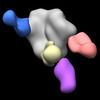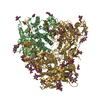[English] 日本語
 Yorodumi
Yorodumi- EMDB-27600: BG505 MD39 SOSIP in complex with Rh.L614 wk13 base, N335/N289, V5... -
+ Open data
Open data
- Basic information
Basic information
| Entry |  | |||||||||
|---|---|---|---|---|---|---|---|---|---|---|
| Title | BG505 MD39 SOSIP in complex with Rh.L614 wk13 base, N335/N289, V5/C3 and N611 epitope pAbs | |||||||||
 Map data Map data | Rh.L614 wk13 base, N335/N289 and N611 pAbs (main map) | |||||||||
 Sample Sample |
| |||||||||
 Keywords Keywords | polyclonal antibodies / HIV-1 / Env / non-human primate / VIRAL PROTEIN | |||||||||
| Biological species |    Human immunodeficiency virus 1 Human immunodeficiency virus 1 | |||||||||
| Method | single particle reconstruction / negative staining / Resolution: 25.0 Å | |||||||||
 Authors Authors | Sewall LM / Richey ST / Ozorowski G / Ward AB | |||||||||
| Funding support |  United States, 2 items United States, 2 items
| |||||||||
 Citation Citation |  Journal: Nature / Year: 2022 Journal: Nature / Year: 2022Title: Long-primed germinal centres with enduring affinity maturation and clonal migration. Authors: Jeong Hyun Lee / Henry J Sutton / Christopher A Cottrell / Ivy Phung / Gabriel Ozorowski / Leigh M Sewall / Rebecca Nedellec / Catherine Nakao / Murillo Silva / Sara T Richey / Jonathan L ...Authors: Jeong Hyun Lee / Henry J Sutton / Christopher A Cottrell / Ivy Phung / Gabriel Ozorowski / Leigh M Sewall / Rebecca Nedellec / Catherine Nakao / Murillo Silva / Sara T Richey / Jonathan L Torres / Wen-Hsin Lee / Erik Georgeson / Michael Kubitz / Sam Hodges / Tina-Marie Mullen / Yumiko Adachi / Kimberly M Cirelli / Amitinder Kaur / Carolina Allers / Marissa Fahlberg / Brooke F Grasperge / Jason P Dufour / Faith Schiro / Pyone P Aye / Oleksandr Kalyuzhniy / Alessia Liguori / Diane G Carnathan / Guido Silvestri / Xiaoying Shen / David C Montefiori / Ronald S Veazey / Andrew B Ward / Lars Hangartner / Dennis R Burton / Darrell J Irvine / William R Schief / Shane Crotty /  Abstract: Germinal centres are the engines of antibody evolution. Here, using human immunodeficiency virus (HIV) Env protein immunogen priming in rhesus monkeys followed by a long period without further ...Germinal centres are the engines of antibody evolution. Here, using human immunodeficiency virus (HIV) Env protein immunogen priming in rhesus monkeys followed by a long period without further immunization, we demonstrate germinal centre B (B) cells that last for at least 6 months. A 186-fold increase in B cells was present by week 10 compared with conventional immunization. Single-cell transcriptional profiling showed that both light- and dark-zone germinal centre states were sustained. Antibody somatic hypermutation of B cells continued to accumulate throughout the 29-week priming period, with evidence of selective pressure. Env-binding B cells were still 49-fold above baseline at 29 weeks, which suggests that they could remain active for even longer periods of time. High titres of HIV-neutralizing antibodies were generated after a single booster immunization. Fully glycosylated HIV trimer protein is a complex antigen, posing considerable immunodominance challenges for B cells. Memory B cells generated under these long priming conditions had higher levels of antibody somatic hypermutation, and both memory B cells and antibodies were more likely to recognize non-immunodominant epitopes. Numerous B cell lineage phylogenies spanning more than the 6-month germinal centre period were identified, demonstrating continuous germinal centre activity and selection for at least 191 days with no further antigen exposure. A long-prime, slow-delivery (12 days) immunization approach holds promise for difficult vaccine targets and suggests that patience can have great value for tuning of germinal centres to maximize antibody responses. | |||||||||
| History |
|
- Structure visualization
Structure visualization
| Supplemental images |
|---|
- Downloads & links
Downloads & links
-EMDB archive
| Map data |  emd_27600.map.gz emd_27600.map.gz | 20.7 MB |  EMDB map data format EMDB map data format | |
|---|---|---|---|---|
| Header (meta data) |  emd-27600-v30.xml emd-27600-v30.xml emd-27600.xml emd-27600.xml | 19.7 KB 19.7 KB | Display Display |  EMDB header EMDB header |
| Images |  emd_27600.png emd_27600.png | 53.3 KB | ||
| Filedesc metadata |  emd-27600.cif.gz emd-27600.cif.gz | 4.5 KB | ||
| Others |  emd_27600_additional_1.map.gz emd_27600_additional_1.map.gz emd_27600_half_map_1.map.gz emd_27600_half_map_1.map.gz emd_27600_half_map_2.map.gz emd_27600_half_map_2.map.gz | 8.3 MB 20.7 MB 20.7 MB | ||
| Archive directory |  http://ftp.pdbj.org/pub/emdb/structures/EMD-27600 http://ftp.pdbj.org/pub/emdb/structures/EMD-27600 ftp://ftp.pdbj.org/pub/emdb/structures/EMD-27600 ftp://ftp.pdbj.org/pub/emdb/structures/EMD-27600 | HTTPS FTP |
-Validation report
| Summary document |  emd_27600_validation.pdf.gz emd_27600_validation.pdf.gz | 708.3 KB | Display |  EMDB validaton report EMDB validaton report |
|---|---|---|---|---|
| Full document |  emd_27600_full_validation.pdf.gz emd_27600_full_validation.pdf.gz | 707.9 KB | Display | |
| Data in XML |  emd_27600_validation.xml.gz emd_27600_validation.xml.gz | 10.6 KB | Display | |
| Data in CIF |  emd_27600_validation.cif.gz emd_27600_validation.cif.gz | 12.3 KB | Display | |
| Arichive directory |  https://ftp.pdbj.org/pub/emdb/validation_reports/EMD-27600 https://ftp.pdbj.org/pub/emdb/validation_reports/EMD-27600 ftp://ftp.pdbj.org/pub/emdb/validation_reports/EMD-27600 ftp://ftp.pdbj.org/pub/emdb/validation_reports/EMD-27600 | HTTPS FTP |
-Related structure data
| Related structure data | C: citing same article ( |
|---|
- Links
Links
| EMDB pages |  EMDB (EBI/PDBe) / EMDB (EBI/PDBe) /  EMDataResource EMDataResource |
|---|
- Map
Map
| File |  Download / File: emd_27600.map.gz / Format: CCP4 / Size: 27 MB / Type: IMAGE STORED AS FLOATING POINT NUMBER (4 BYTES) Download / File: emd_27600.map.gz / Format: CCP4 / Size: 27 MB / Type: IMAGE STORED AS FLOATING POINT NUMBER (4 BYTES) | ||||||||||||||||||||||||||||||||||||
|---|---|---|---|---|---|---|---|---|---|---|---|---|---|---|---|---|---|---|---|---|---|---|---|---|---|---|---|---|---|---|---|---|---|---|---|---|---|
| Annotation | Rh.L614 wk13 base, N335/N289 and N611 pAbs (main map) | ||||||||||||||||||||||||||||||||||||
| Projections & slices | Image control
Images are generated by Spider. | ||||||||||||||||||||||||||||||||||||
| Voxel size | X=Y=Z: 1.77 Å | ||||||||||||||||||||||||||||||||||||
| Density |
| ||||||||||||||||||||||||||||||||||||
| Symmetry | Space group: 1 | ||||||||||||||||||||||||||||||||||||
| Details | EMDB XML:
|
-Supplemental data
-Additional map: Rh.L614 wk13 V5/C3 pAb (additional map 1)
| File | emd_27600_additional_1.map | ||||||||||||
|---|---|---|---|---|---|---|---|---|---|---|---|---|---|
| Annotation | Rh.L614 wk13 V5/C3 pAb (additional map 1) | ||||||||||||
| Projections & Slices |
| ||||||||||||
| Density Histograms |
-Half map: Rh.L614 wk13 base, N335/N289 and N611 pAbs (half map 1)
| File | emd_27600_half_map_1.map | ||||||||||||
|---|---|---|---|---|---|---|---|---|---|---|---|---|---|
| Annotation | Rh.L614 wk13 base, N335/N289 and N611 pAbs (half map 1) | ||||||||||||
| Projections & Slices |
| ||||||||||||
| Density Histograms |
-Half map: Rh.L614 wk13 base, N335/N289 and N611 pAbs (half map 2)
| File | emd_27600_half_map_2.map | ||||||||||||
|---|---|---|---|---|---|---|---|---|---|---|---|---|---|
| Annotation | Rh.L614 wk13 base, N335/N289 and N611 pAbs (half map 2) | ||||||||||||
| Projections & Slices |
| ||||||||||||
| Density Histograms |
- Sample components
Sample components
-Entire : BG505 MD39 SOSIP in complex with Rh.L614 wk13 base, N335/N289, an...
| Entire | Name: BG505 MD39 SOSIP in complex with Rh.L614 wk13 base, N335/N289, and N611 epitope pAbs |
|---|---|
| Components |
|
-Supramolecule #1: BG505 MD39 SOSIP in complex with Rh.L614 wk13 base, N335/N289, an...
| Supramolecule | Name: BG505 MD39 SOSIP in complex with Rh.L614 wk13 base, N335/N289, and N611 epitope pAbs type: complex / ID: 1 / Parent: 0 |
|---|
-Supramolecule #2: Rh.L614 wk13 base, N335/N289, and N611 epitope pAbs
| Supramolecule | Name: Rh.L614 wk13 base, N335/N289, and N611 epitope pAbs / type: complex / ID: 2 / Parent: 1 |
|---|---|
| Source (natural) | Organism:  |
-Supramolecule #3: BG505 MD39 SOSIP
| Supramolecule | Name: BG505 MD39 SOSIP / type: complex / ID: 3 / Parent: 1 |
|---|---|
| Source (natural) | Organism:   Human immunodeficiency virus 1 Human immunodeficiency virus 1 |
-Experimental details
-Structure determination
| Method | negative staining |
|---|---|
 Processing Processing | single particle reconstruction |
| Aggregation state | particle |
- Sample preparation
Sample preparation
| Concentration | 0.02 mg/mL |
|---|---|
| Buffer | pH: 7.4 |
| Staining | Type: NEGATIVE / Material: Uranyl formate |
- Electron microscopy
Electron microscopy
| Microscope | FEI TECNAI F20 |
|---|---|
| Image recording | Film or detector model: TVIPS TEMCAM-F416 (4k x 4k) / Average electron dose: 25.0 e/Å2 |
| Electron beam | Acceleration voltage: 200 kV / Electron source:  FIELD EMISSION GUN FIELD EMISSION GUN |
| Electron optics | Illumination mode: FLOOD BEAM / Imaging mode: BRIGHT FIELD / Nominal defocus max: 1.5 µm / Nominal defocus min: 1.0 µm |
| Sample stage | Specimen holder model: SIDE ENTRY, EUCENTRIC |
| Experimental equipment |  Model: Tecnai F20 / Image courtesy: FEI Company |
- Image processing
Image processing
| Startup model | Type of model: PDB ENTRY PDB model - PDB ID: |
|---|---|
| Final reconstruction | Applied symmetry - Point group: C1 (asymmetric) / Resolution.type: BY AUTHOR / Resolution: 25.0 Å / Resolution method: FSC 0.5 CUT-OFF / Software - Name: RELION (ver. 3.0) / Number images used: 3148 |
| Initial angle assignment | Type: MAXIMUM LIKELIHOOD |
| Final angle assignment | Type: MAXIMUM LIKELIHOOD |
 Movie
Movie Controller
Controller
















 Z (Sec.)
Z (Sec.) Y (Row.)
Y (Row.) X (Col.)
X (Col.)













































